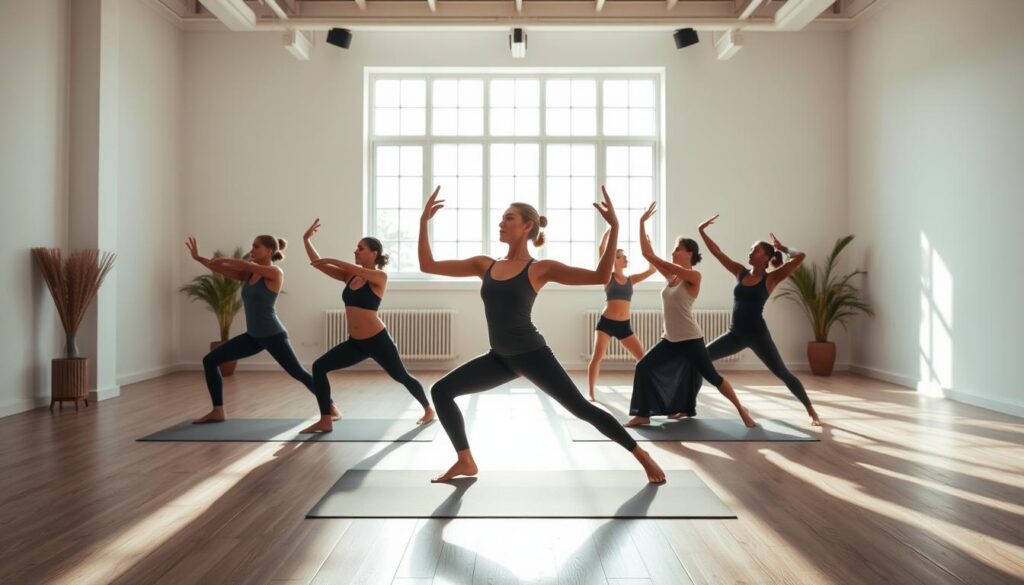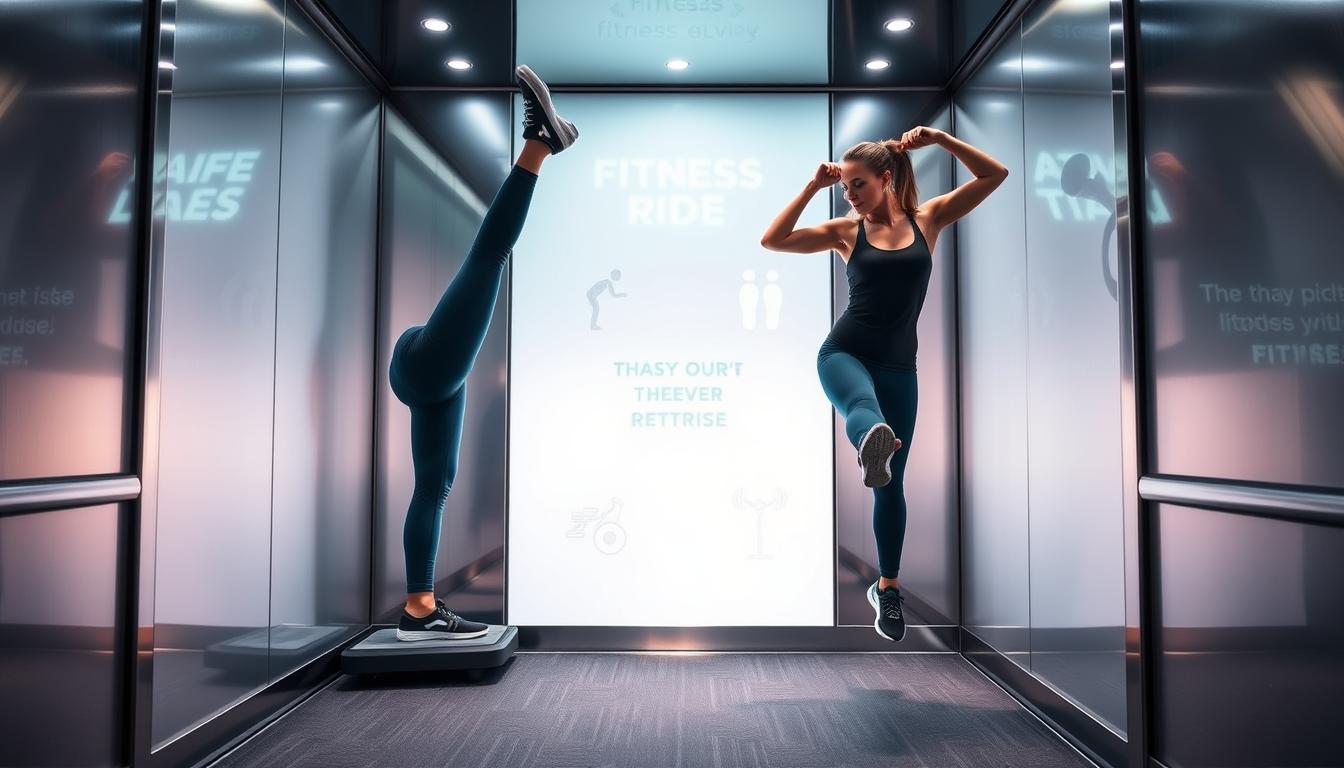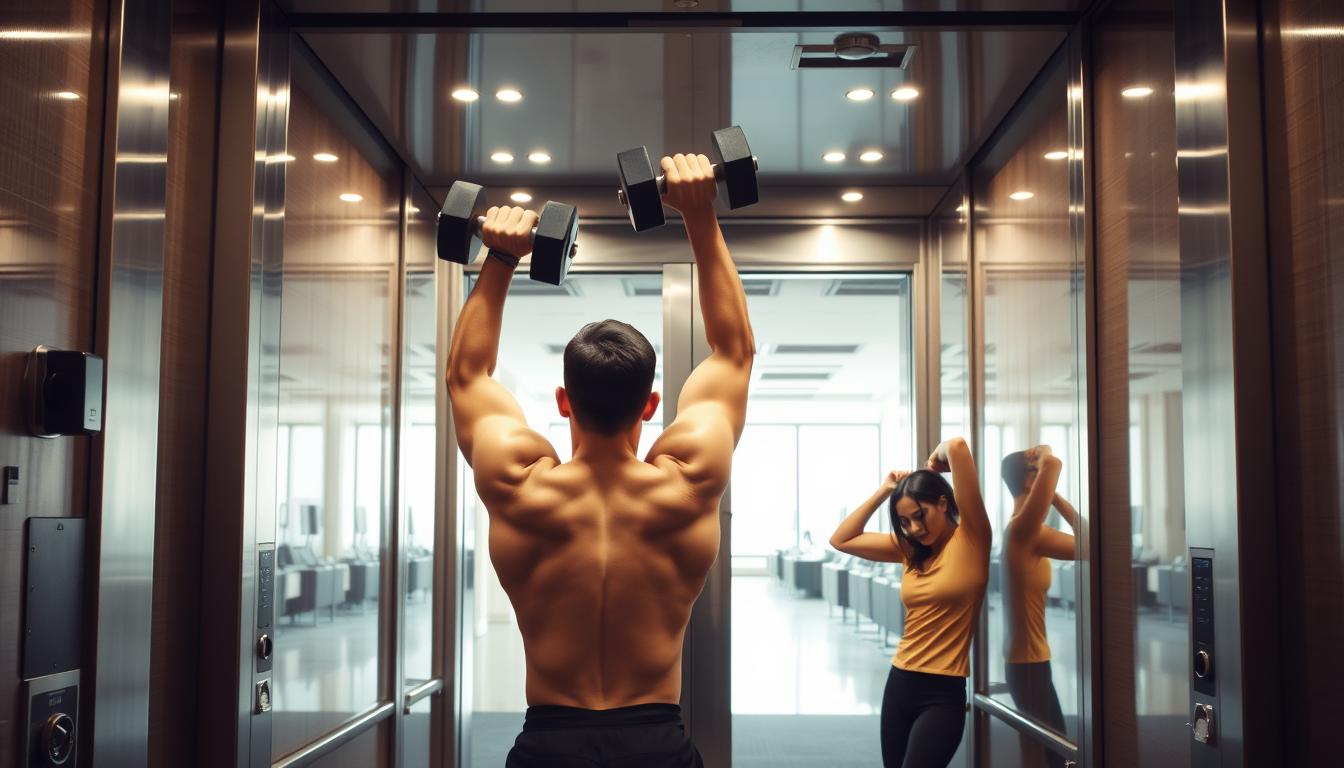Finding time to exercise is hard in today’s fast world. Elevator workouts offer a great fix for folks who need to keep moving but have little space. These exercises need no equipment and can be done anywhere, anytime.
By using your own body weight, it’s easy to fit a quick workout into your day. This can be at work or even in your living room. Learn how to use these simple but effective moves to boost your fitness, no gym needed.
Introduction to Elevator Workouts
Elevator workouts offer a cool way to keep fit in our busy world. They are perfect for people who are always on the go. These exercises give you short fitness activities that need little space. The idea is to do workouts while doing daily tasks, making fitness easy to add to a busy day.
Doing quick exercises during the day is good for your body and mind. With elevator workouts, you can use time spent in elevators to work out. This shows you don’t need a gym or lots of time to stay fit.
The Benefits of No-Equipment Workouts
No-equipment workouts are really popular. They offer a flexible and convenient way to get fit. You can build strength, endurance, and flexibility without needing special gear or a gym.
You can do these routines almost anywhere. Climbing stairs burns more calories than jogging. This makes it an awesome no-equipment exercise. Push-ups, squats, and jumping jacks can easily fit into your day too.
Working out at home has clear benefits. It’s hard for many adults to exercise enough each week. Adding things like yoga and meditation can make you feel great, no gear needed. Activities like brisk walking are good for people at any fitness level.
Choosing no-equipment workouts also helps your mind. Regular exercise makes you feel more alive and happy. Keep it up, and you’ll see big improvements in your overall health.
Understanding Bodyweight Exercises
Bodyweight exercises use your own weight to work against, making it a good kind of resistance training for all fitness levels. They are flexible enough for both newbies and those who are more advanced. Exercises like squats, push-ups, and planks are a solid start in strength training. For those looking for more of a challenge, there are tougher bodyweight exercises like hanging leg raises and hollow body holds.
Making sure you use the right form and technique is crucial. It helps you get the most out of the exercise and avoids injuries. Especially as you move to harder bodyweight challenges. Key basic exercises are:
- Push-ups: Work your chest, shoulders, triceps, and core. You can start easy with wall push-ups and incline push-ups. Then move on to more difficult ones like diamond push-ups to up the challenge.
- Dips: Focus on the chest, shoulders, and triceps. Beginners might like leg-assisted dips or those with resistance bands to build up strength.
- Pull-ups: Improve your back, biceps, and grip strength. If you’re just starting, try assisted or band-assisted pull-ups.
- Squats: Target the quads, hamstrings, and glutes. You can begin with easier versions like chair squats or assisted squats.
- Handstand: Boosts shoulder strength and mobility. Starting with wall-assisted handstands is a good way to build up confidence and strength.
- Arch-ups: Aim at the lower back and core stability. Try bent-leg arch-ups for different levels of challenge.
- Hollow Hold: A key exercise for the core. For more challenge, try adding weights or rocking motions.
- Plank: A basic move that strengthens the core. You can modify it with knee-supported or one-arm planks.
Studies show that regular bodyweight workouts can boost your physical fitness and also make you feel better. They help lower stress, anxiety, and depression. This mix of mental and physical perks makes bodyweight exercises a great choice for those looking for effective and accessible workout options.
Key Muscle Groups Targeted in Elevator Workouts
Elevator workouts hit many muscles at once. They focus on the upper body, core, and lower body. Knowing which muscles to work on makes your training better.
The upper body gets stronger with push-ups, tricep dips, and shoulder presses. These exercises don’t need extra gear. Meanwhile, the back, biceps, and traps require moves like pull-up holds, bicep curls, and shrugs.
For legs, think quadriceps, hamstrings, glutes, and calves. Squats, lunges, and calf raises build these areas. They fit well in an elevator workout. Core exercises, like planks, bicycle crunches, and leg raises, focus on your abs and lower back.
Doing moves that work many muscles at once, like burpees, jump squats, and mountain climbers, is smart. It boosts strength and overall fitness. Aiming at the chest, back, arms, abs, legs, and shoulders gives you a well-rounded routine.
Workout Routines with No Equipment in Elevator
Exercises in the elevator without equipment are a great way to keep moving. They are good for beginners, people who are more advanced, and those at the top of their game. Each plan is designed to increase strength and stamina, while making sure you do it right.
Beginner Routine
If you’re new to working out, start with these simple exercises:
- Bodyweight Squats: 3 sets of 12-15 reps
- Modified Push-Ups: 3 sets of 10-12 reps
- Glute Bridges: 3 sets of 10-12 reps
- Bird Dog: 3 sets of 8-10 reps
- Hollow Hold: 3 sets of 45 seconds to 1 minute
Intermediate Routine
Those who have been exercising a bit can try these tougher moves:
- Standard Push-Ups: 3 sets of 12-15 reps
- Close-Grip Push-Ups: 3 sets of 10-12 reps
- Backward Lunges: 3 sets of 10-12 reps per side
- Mountain Climbers: 3 sets of 45 seconds on, 15 seconds off
- Lateral Squat Shuffles: 3 sets of 10-12 reps
Advanced Routine
For fitness buffs looking for a real test, try these hard exercises:
- Jump Squats: 3 sets of 10-12 reps
- Archer Push-Ups: 3 sets of 6-10 reps per side
- Burdens: 3 sets of 10-12 reps
- Plank Jacks: 3 sets of 10-12 reps
- Skaters: 3 sets of 12-15 reps per side
Example Elevator Workout Carousel
The elevator workout carousel is great for a full-body workout in tight spots. It’s perfect for busy folks or those always moving. You can quickly go through different exercises, making workouts fun. The use of simple bodyweight exercises means anyone can do it, no matter their fitness level.
Try these elevator workout moves in your routine:
- Push-ups: Engage your chest and triceps while maintaining proper form.
- Bodyweight Squats: Strengthen your legs and core with controlled repetitions.
- Lunges: Target your glutes and quads with a forward or reverse motion.
- Plank Holds: Build core stability and endurance for overall fitness.
- Jumping Jacks: Increase your heart rate while getting dynamic with movement.
Switching between these exercises keeps your heart rate up. This boosts calorie burning and makes the workout more effective. Smoothly moving from one exercise to the next keeps you focused. It also keeps you energized, making every minute count.
Tips for Maximizing Elevator Workouts
Elevator workouts are a great way to stay fit without any equipment. To get the most out of your workouts, focus on key tips. These tips can really up your fitness game.
Watching your form is super important. It helps avoid injuries and makes sure you’re working the right muscles. Look at yourself in the mirror or record your exercises. This will help a lot in improving your performance.
How you breathe matters a lot. Breathe in when it’s easy and out when it’s harder. This makes your workout more effective and helps you keep going.
Drink plenty of water to stay energized. Have water before, during, and after exercising. Staying hydrated boosts your workout and helps with recovery.
It’s key to listen to what your body tells you. Change up your exercises to stay comfortable and safe. This way, you avoid injuries and get better results over time.
Having a regular workout schedule keeps you on track. Pick specific days and times for your elevator workouts. This helps with sticking to your goals and staying motivated.
Incorporating Flexibility and Mobility
Flexibility and mobility are key for better fitness and health. To get the most out of mobility in your workouts, adding good warm-up and cool-down routines is key. A well-done warm-up gets your body ready for exercise. A smart cool-down helps with recovery and keeps muscles flexible.
Dynamic Warm-Up Exercises
Dynamic warm-up exercises increase flexibility and get the blood moving. Think about doing these exercises:
- Plank Shoulder Taps: Improves shoulder mobility and core stability while maintaining alignment.
- Tricep Dips: Strengthens shoulders and triceps, boosting upper body flexibility.
- Resisted Push-Ups: Utilizes a resistance band to target the chest, shoulders, and triceps, enhancing upper body mobility.
- Bilateral Arm Raises: Encourages shoulder flexibility when using resistance bands.
- Lunges: Increases hip mobility and strengthens the legs, promoting lower body flexibility.
- Front Squats: Targets the quadriceps, hamstrings, and glutes, enhancing mobility with a resistance band.
- Single Leg RDL (Romanian Deadlift): Improves hip flexibility and balance, focusing on hamstrings and glutes.
Cool Down Techniques
Effective cool-down techniques aid in recovery and keep flexibility after workouts. Key methods include:
- Stretch to Improve Flexibility: Full-body stretches post-exercise help increase range of motion.
- Use Resistance Bands: Integrating these tools can enhance mobility during cool-down routines.
- Gentle Walks: Light movements facilitate active recovery and support flexibility.
- Sitting Stretch: A knee-to-chest stretch is particularly effective in small spaces, such as an elevator.
- Hip Circles: This exercise improves lower body flexibility and can easily be performed in tight areas.

The Importance of Consistency in Fitness
Consistency is the secret to real change in fitness and health. Starting and keeping a routine boosts strength, endurance, and happiness. Many people find it hard to keep up with their exercise habits. This is often because staying committed to a fitness plan is challenging.
Breaking commitments into easier, smaller steps helps keep a routine going. Try to exercise a bit every day, even if it’s only 20 minutes. Doing simple things daily, like using stairs or walking on your break, helps keep your fitness goals on track.
Short workouts of 10-15 minutes fit into busy days easily. These quick exercises can be things like squats, push-ups, and lunges. With these short workouts, you can keep active, even when your schedule is full.
Adding exercise to your daily life, like choosing stairs over elevators, increases your overall activity. Fitness apps are great for keeping you on track, offering guided workouts and tracking your progress. High-Intensity Interval Training (HIIT) is another good option. It gives you short, 20- to 30-minute workouts that are perfect for busy days.
Making regular exercise more important than being perfect is key. Even short workouts done regularly can turn into lasting habits. By sticking to small, frequent efforts, you can reach your fitness goals.
How to Track Your Progress
Tracking your fitness journey is key to success. There are many ways to keep track of your workouts and progress. These methods help you move steadily towards your fitness goals.
Smartphone apps and fitness trackers are great tools. Apps like SmartWOD and SugarWOD let you record workouts and see your progress. They also let you connect with others for motivation.
It’s important to set goals that you can reach. Begin with workouts that are easy to manage and slowly make them harder. Pliability offers programs to help track improvement, enhance flexibility, and lessen pain.
Looking at how you work out can help you change and improve. Keeping an eye on things like heart rate or calories burned shows if you’re on the right track. Celebrate when you hit big goals to keep up your energy.
Change how you track your progress to keep things interesting. Beyond the Whiteboard logs your workouts and tracks your best performances. With this method, you’ll keep pushing yourself forward on your fitness path.
Additional Resources for Home Workouts
Finding great home workout sources can make your fitness journey better. Many websites offer tips on exercising without gym gear. They focus on easy, effective moves like squats, push-ups, and planks to build strength.
Adding items like resistance bands or small dumbbells can add fun to your workouts. You can also use local parks for more workout options, like pull-ups on playground gear.
Short, intense workout sessions are perfect for those who are always busy. Choosing to walk or use stairs over elevators is a simple way to stay fit. Stretching helps with flexibility and eases tight muscles, too.
Staying regular with these tips can improve your health all around. Mix up your exercises to keep things fun and work out efficiently. Look into apps that offer quick exercises and help you do them right, avoiding injury.
Conclusion
Fitting fitness into our daily lives can be easy with creative methods like elevator exercises. These simple workouts don’t need special equipment. They give big health perks without taking much time or a gym visit. For those always on the go, short but frequent workouts can improve heart health, metabolism, and strengthen muscles.
The VECTOR Resistance System makes these quick exercises even better. It allows for adjustable resistance, so you can work out effectively anywhere. Doing these exercises regularly is great for both your body and mind. It makes staying in shape fun and a normal part of your day.
When thinking about exercise, know that you don’t have to go all out to see results. What really matters is keeping at it and having fun. By adding these flexible workouts to your routine, you’re on your way to a healthy and happy lifestyle. It’s all about what works best for you.



